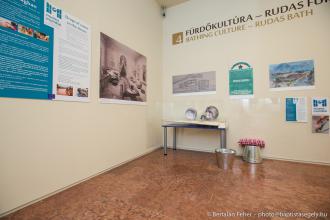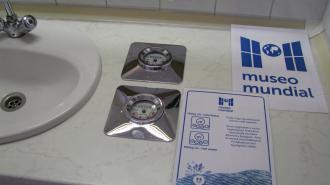Hogyan készül - lépésről lépésre
1st Step:
Choose object and topic
Water as a topic was an evident subject in the Budapest History Museum since one of the recently renewed permanent exhibitions about the history of Budapest displays the culture of water cures in the sense of the Turkish spas in Budapest. Basically, these units elaborate one topic in one room, but seen over different centuries. This is how the fractions of a Turkish bath tubs and swimsuits from the 20th century can be next to each other in the exhibition. Moreover, there is a poster which declares that ‘so far only the rich people had the opportunity to go to baths, but from now on the public baths are open to everyone’. The availability of clean water in different parts of the world got thereby a place in this exhibition.
In addition, we wanted to surprise the visitors by reaching them at a place they would not expect it. This is why we chose the restrooms, where we had planned to install water measuring devices both on the taps and toilet tanks.
2nd Step:
Check technical preconditions
We had to find some sites in the permanent exhibitions where we could place the tools and in this respect, the chosen room was adequate. We wanted to symbolize the waterdrops with little balls, which would fill the buckets. However the balls could not have been made of glass, because they would have been shattered on the marble floor of the exhibition. They could not have been too small either, in order to prevent any accidents like being swallowed by children standing next to the table. The plexiglass was chosen because it seemed to be the most translucent material and thereby symbolizing water. Eventually we decided on paper balls because their size was proper and their prices affordable.
3rd Step:
Cost estimates
To create such an installation, not just graphic designers but also an interior architect or installation designer was needed to plan the operations of the plexiglass table. If there is a colleague available with whom you often work with or perhaps the one who created the exhibition as well that would be the easiest solution. The designing process is not cheap and the prices can be very different. Besides, the cheapest option doesn’t have to be the best.
Further questions concern the materials and the implementation of the installation. In this case, we could not get hold of a water meter, on what the amount of water consumed can be read easily, so we had to pay attention to the explanatory diagrams to each.
4th Step:
Create content
Determining the content, an initial aim was to bring this issue to the visitors’ notice. This gave the main content of the restrooms. In the spa culture section the most determining issue was to explain why they need to pay attention and how it works in other places and countries. So our goal was to answer these questions the visitors would raise. At this station, according to the feedbacks, it is especially popular that there is also some advice written how the water consumption can be reduced.
5th Step:
Last corrections
When we want to explain more serious contents with shorter texts, it is worth to check and interpret it by outsiders. The effect is greater if we formulate the message simpler but clear.
6th Step:
Implementation
In a museum, it is possible that such an installation with two stations cannot be built in that one day of the week when the museum is closed. It is advised to schedule the implementation process and the placement of the inscriptions in a way that it would not bother or confuse the visitors if by chance a semi-finished item is there for a few days.
7th Step
Maintenance
The installation and its surrounding area should be constantly checked because people like to decorate the walls with inscriptions, writings etc.





















